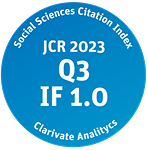Página principal
Convocatorias
Instrucciones para autores
Novedades
Políticas
Reseñas bibliográficas
Revisores
Todos los números
Sobre la revista
La REP es una revista científica cuyo foco de interés son trabajos centrados en el estudio de la educación, en general, más allá de las áreas de conocimiento de sus autores. Tiene vocación universal, y por ello publica originales de cualquier parte del mundo, siempre que estén asociados a temas de relevancia o actualidad en el debate educativo.
Número actual
Vol. 83 Núm. 291 (2025)
Publicado:
2025-06-24
Número completo
Artículo invitado
Artículo
-
Burnout y salud mental en trabajadores españoles que desempeñan labores educativas y de inclusión en el tercer sector de acción social
-
Resumen 144
-
PDF 82
-
PDF (English) 22
-
Resumen 144
-
Manifestaciones de (des)igualdad y estereotipos de género en #TikTokchallenges físico-motrices: un estudio cualitativo
-
Resumen 74
-
PDF 41
-
PDF (English) 21
-
Resumen 74
-
Prácticum mediado por foto-elicitación: aportación a la formación inicial docente y a la permanente del profesorado-tutor
-
Resumen 78
-
PDF 31
-
PDF (English) 8
-
Resumen 78
-
La tutoría entre iguales para la mejora de la competencia escrita en educación primaria
-
Resumen 105
-
PDF 56
-
PDF (English) 12
-
Resumen 105
-
Sensibilidad intercultural del profesorado hacia el colectivo inmigrante: una investigación mixta con tres escuelas públicas
-
Resumen 82
-
PDF 34
-
PDF (English) 11
-
Resumen 82
-
Humanizar la universidad para transitar hacia un modelo más inclusivo. Una aproximación desde la pedagogía social
-
Resumen 76
-
PDF 41
-
PDF (English) 12
-
Resumen 76
Reseñas bibliográficas
-
Reseña bibliográfica: Cantón-Mayo, I. (2024). Las escuelas rurales del valle de Jamuz y la Valdería. Eolas Ediciones. 354 pp.
-
Resumen 67
-
PDF 10
-
PDF (English) 10
-
Resumen 67









